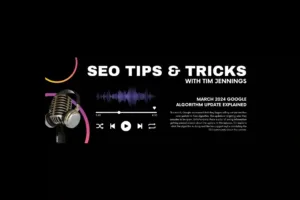The Importance Of Subheadlines and How To Use Them Properly
As a writer or content creator, you understand the power of words and how they can make or break your content. This is where subheadlines come in – they provide structure, clarity, and organization to your writing, making it easier for readers to navigate and comprehend your message. Not only do subheadlines make your content more readable, but they are also important for SEO. Search engines use subheadlines to understand the structure and hierarchy of your content, which helps them to better understand the context and relevance of your page.

In this episode of Soulheart’s Search Engine Optimization Tips and Tricks podcast, we will explore why subheadlines are important and provide practical tips on how to use them effectively. Whether you’re a blogger, podcaster, or content marketer, mastering the art of subheadlines will take your content to the next level. So, grab a cup of coffee and join us as we delve into the world of subheadlines.
What to Listen For
- Subheadlines: What are they? - 0:01
- Why Are Subheadlines Important For SEO? - 1:39
- Bad Subheadings - 2:24
- Good Subheadings - 6:53
- Final Thoughts On Subheadlines - 12:01
Transcript
Introduction
Welcome to Soulheart’s SEO Tips and Tricks Podcast. I’m Tim Jennings and have been the Head of SEO for over 8 years at Soulheart. On this podcast, we discuss the latest strategies to improve your website’s search engine performance. In this episode, we’ll be discussing subheadlines – what they are, why they are important, and how to use them effectively to improve your SEO.
Subheadlines, also known as subheadings or headings, are the smaller headlines that come after the main headline or title in an article or blog post on a website. They are used to break up the content into smaller, more manageable sections and help to make the text more readable.
Subheadlines are typically smaller in font size than the main headline, and they may be bolded or italicized to make them stand out from the body text. They are often used to introduce a new section or topic, summarize key points, or provide a transition between different parts of the content.
Why Are Subheadlines Important For SEO?
Subheadlines are important for search engine optimization (SEO) because they help search engines understand the structure and hierarchy of your content. By using subheadlines, you signal to search engines which parts of your content are most important and which topics are covered in each section. This helps search engines prioritize your content and improve your chances of ranking for relevant keywords.
Subheadlines also make your content more readable and scannable for users. When users search for a specific topic, they’ll often scan through the subheadlines to see if the article covers what they’re interested in. If your subheadlines are clear and descriptive, users are more likely to click on your article and stay on your site longer. Anytime you can provide a user with a positive experience and keep them on your site longer, you are only improving your website’s SEO efforts.
Using keywords in your subheadlines can help search engines understand the topics you’re covering and improve your chances of ranking for those keywords.
Bad Subheadings
A bad subheading can negatively impact SEO in a few ways. First off, it may confuse both readers and search engines about the topic and relevance of the content, leading to a lower click-through rate from search engine results pages and negatively impacting the page’s overall traffic and ranking. Also, if the subheadline is unrelated, too long or too short, repetitive, or lacking in keywords, it can miss an opportunity to signal to search engines the structure and hierarchy of the content, as well as the topics and keywords being covered. This can lead to a lower relevance score for the page, which can negatively impact its ranking in search engine results.
In summary, a bad subheadline can confuse readers and search engines, mislead them about the topic and focus of the content, and miss an opportunity to signal the relevance and structure of the content to search engines. All of these can negatively impact the SEO performance of a page, resulting in lower traffic, CTR, and ranking in search engine results. Here are 7 examples of bad subheadlines:
- A Subheading That Is Vague or Ambiguous: Subheadlines that are too vague or ambiguous can confuse readers and make it difficult for them to understand what the content is about. For example, a subheadline like “Learn More” doesn’t provide any real information about what the content covers.
- Subheadlines That Are Unrelated to the Content: Subheadlines that are unrelated to the content can be misleading and frustrating for readers. For example, a subheadline like “The Best Pizza in Town” might lead readers to expect an article about pizza, only to find that the content is actually about a different topic.
- Subheadlines That Are Too Long or Too Short: Subheadlines that are too long or too short can also be ineffective. A subheadline that is too long can be overwhelming and difficult to read, while a subheadline that is too short may not provide enough information to entice readers to continue reading.
- Repetitive or Redundant Subheadings: Subheadlines that repeat the same information as the main headline or the body text can be redundant and unhelpful. For example, a subheadline like “Why You Should Choose Our Product” might repeat the same information as the main headline, “Introducing Our New Product.”
- Subheadings That Are Lacking in Keywords: Subheadlines that don’t include relevant keywords can also be a missed opportunity for SEO. Including keywords in your subheadlines can help search engines understand the topics you’re covering and improve your chances of ranking for those keywords.
- Subheadlines That Are Used For Design Purposes Only: Unfortunately, one of the ways subheadlines are frequently used improperly is when a content creator uses them only as a design feature on the page. Subheadlines should be used to separate content into different thoughts. If you want to or are using them for design aesthetics only then you should be doing that through CSS.
- Subheadings That Lack Structure: The other way that many people improperly use subheadings is by not thinking through the structure. Structure is important when talking about subheadings because a clear and logical structure with well-crafted subheadings can help to improve the user experience and engagement, and signal to search engines the relevance and value of the content. This can result in higher rankings in search engine results, more traffic, and ultimately, more conversions and business success. If you lack structure then you are going to confuse both the users and search engines alike.
Good Subheadings
A good subheading will delight your user and will help search engines understand your content and as a result, help you appear in the search results pages also known as the SERPS. Here is how you can create great subheadings that will make an impact:
The first way to properly use subheadings is to use descriptive and relevant subheadlines: Your subheadlines should be brief and accurately describe the content that follows. Avoid using clickbait titles or overly clever language; instead, focus on writing clear, concise headings that reflect your content accurately.
Next, you will want to make sure to include keywords in your subheadings: Search engines analyze the text and HTML structure of a page to determine the main topics and themes, and keywords are an important signal that helps them to understand the focus and relevance of the content. Just like your body text, subheadlines should include relevant keywords to help search engines understand the content of your page.
By using relevant keywords in your subheadings, you can help search engines to identify the main topics and themes of your content, and to rank it higher in search engine results pages for relevant search queries. This can lead to more traffic, higher click-through rates, and ultimately, more business success.
However, it’s important to use keywords in a natural and meaningful way, rather than “keyword stuffing” or cramming in as many keywords as possible. Your subheadings should accurately reflect the content of the page or article, and should be crafted with the reader in mind, rather than solely for the purpose of SEO.
When used effectively, keywords in subheadings can help to improve the overall user experience and engagement, as well as boost the SEO performance of your content.
The 3rd way to properly use subheadlines is to Use header tags correctly: Use header tags (H1, H2, H3, etc.) to categorize your subheadlines based on their importance. H1 tags are typically reserved for the title of the page or article, followed by H2 and H3 tags for subtopics.
The way I like to think about the structure of subheadings is to think about the Outline Note-Taking method. The outline note-taking method is a structured approach to taking notes that involves organizing information hierarchically. To use this method, you start by creating an overarching main heading or topic that summarizes the information you will be taking notes on. You then create subheadings for each major point or theme related to the main heading. Under each subheading, you add supporting details or information.
The main heading is the h1 of your web page. It is the title of your article and should only be used one time. Then your major points are your h2s. They are the Roman Numeral part of the Outline Note-Taking Method. You can use as many or as few as you need. After that, your h3 subheadlines are used for the supporting points of the h2. They would be the numeral part of the Outline Note-Taking Method. If there are supporting points of the supporting point then it would be an h4 subheading and so on and so on until you have h6 tags. When you are done with the supporting points then you go back to the next subtopic of the content and use h2 again.
It is important to note that there is no minimum or maximum amount of subheadlines to use. Nor is there any rule saying have to use all the different subheadlines. Use as many that make sense in a logically structured way. To be honest, it is rare that I go beyond h3, and very rare I go beyond h4.
The last thing I want to make abundantly clear is that just because I am only talking about subheadlines, it does not mean that you will not also have body content as paragraph tags under each of those subheadlines as well.
And finally, the fourth way to create a great subheading is to Break up your content: Large blocks of text can be daunting for readers, leading to a higher bounce rate. Subheadlines can help break up the content, making it more appealing to readers and allowing them to easily navigate the page.
Final Thoughts on Subheadlines
So as you can see, Subheadlines are an important aspect of your website’s SEO. Proper use of subheadlines can help improve the understanding of your content for search engines and readers alike. Remember to use descriptive headings, header tags correctly, include relevant keywords, and break up your content to make it more engaging to read.
That’s all for this episode of Soulheart’s Search Engine Optimization Tips and Tricks Podcast. We hope this guide to subheadlines was helpful. As always, if you have any questions or suggestions for future episodes, feel free to reach out to us.
Before I go I just want to let you know about two things I’m really excited about. 1. I produce bonus content based on each episode that you can find by going to soulheart.co/seo and filling out the form and 2. We have a BRAND NEW marketing community launching soon. I know you’re interested in leveling up your digital marketing game and expanding your knowledge with the latest industry trends and rubbing shoulders with some of our own team of expert practitioners, so get on the waiting list now. Marketing is what powers growth, but not all marketing is equal. Join the waitlist to access this community and learn the best strategies that exist you can start implementing today.
Thanks for listening!
Episode Resources
Get Help With Your SEO Efforts
Whether you’re performing a website overhaul, creating new content, or looking to boost your overall SEO, Soulheart has the SEO tools and expertise to help you. We’d love to learn how we can help you reach your marketing goals this year! Just sign up below to book a chat with us.





